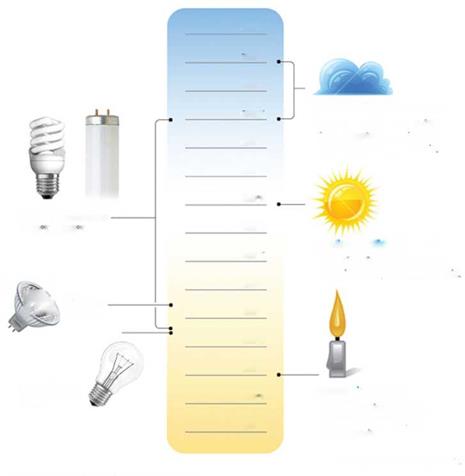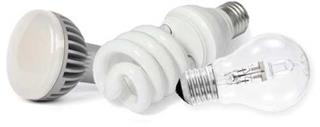Efficacy is a term typically used to quantify how efficiently a lamp turns electricity into light; the higher the efficacy, the more efficient the lamp. Calculate efficacy by dividing the lumen rating by the watts used to operate the lamp. Both figures are usually found on the lamp’s package. Halogen lamps are more efficient than the standard A-type lamp, and fluorescent and LED lamps are more efficient than halogen.
Types of Lamps
Lamp choices have changed significantly in recent years with more variations in light quality, lamp shapes and sizes, voltage requirements, and efficiency. The lamps you select for your client’s lighting needs will depend on the purpose of the light source, the effect you want to achieve, and the fixture in which the lamp will be placed. The following is a brief discussion of the most common lamp types used in the home.
 |
||
 |
||
 Incandescent
Incandescent
The incandescent lamp has been around since 1859 and most homes have used this type of lamp in a majority of their lighting fixtures. The most common type of incandescent lamp that most people think of as a "light bulb" is the A-bulb or "arbitrary" lamp. This lamp is very inexpensive to buy, but they are big heat producers with 90 percent of a standard A-bulb’s energy used to produce heat. Because only 10 percent of the energy goes to light, these are very inefficient lamps, and the reason many of these lamps are being phased out. New energy standards do not ban incandescent use, but do require increased efficiency with the following schedule for the phasing out of the current most inefficient types of standard incandescent lamps as of this publication edition (see Table 7.1). Newer incandescent lamps will be rated by lumens rather than watts.
Incandescent lamps produce light by heating a tungsten filament and as it heats it glows, giving off light. These lamps give off a warm light and come in a wide variety of shapes and sizes. The life of these lamps is 750 to 1500 hours. They can be dimmed and their light becomes warmer as they are dimmed.
|
TABLE 7.1 Phase-Out Dates for the Current Standard Incandescent Lamps
|
FIGURE 7.16 Examples of LED, compact fluorescent, and halogen lamps.
 Clean Energy Resource Teams—www. cleanenergyresourceteams. org/lighting
Clean Energy Resource Teams—www. cleanenergyresourceteams. org/lighting
![]()
Other types of more efficient incandescent lamps (see Figure 7.16), halogen and xenon, are now on the market. These can serve as replacements for the standard incandescent lamps and are available in the low-voltage type as well.
• Halogen—Halogen lamps were introduced in the 1950s and are 25 to 30 percent more efficient than standard incandescent lamps. A halogen is designed a little differently from the standard incandescent, and provides a soft, warm light but less warm than the standard incandescent. Halogen lamps are delicate to handle and emit ultraviolet rays (UV). Covers are available to filter out the UV. They come in a wide variety of shapes, sizes, and wattages, and the lamp life is closer to 3000 hours. These lamps cost more to purchase and become very hot with use.
• Xenon—Xenon lamps can be used interchangeably with halogen but they come in fewer varieties than the halogen. They are only low-voltage at this time. Xenon lamps have many advantages over the halogen in that they operate cooler, do not need special handling, and last about 5000 to 8000 hours. Xenon lamps may cost more than halogen and they do not emit UV rays.
Other styles of incandescent lamps:
• Spot lamps—These lamps focus the light energy into a narrow beam of concentrated light. They are often used as accent lighting.
• Flood lamps—Flood lamps spread the light beam and flood an area with a lower level of light.
• PAR or parabolic aluminized reflector lamps—These lamps have a heavy glass casing and reflective surface. They are often used for outdoor settings, and the low voltage MR-16 lamps can be PAR-style lamps as well.
• reflector lamps—Reflector lamps are incandescent lamps with a reflective coating to reflect more of the light out the front of the lamp. These have been a popular source for recessed can lights but are being replaced by more efficient halogen, LED, and compact fluorescent lamps.



